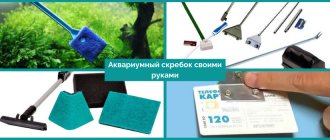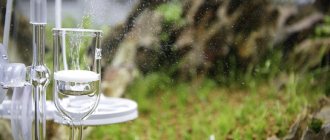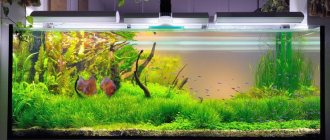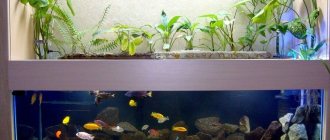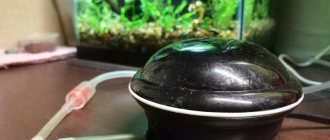Quite often, aquarists, having carefully thought through the internal design of their aquarium, selecting flora and fauna, still consider their home pond to be completely unfinished. This happens due to the fact that one important detail is omitted - the background. To design it unusually and harmoniously requires a lot of effort and time. But if you have patience and diligence, you can beautifully decorate the back wall of your aquarium.
You can make the background yourself
Kinds
There are two types - external and internal. Each type differs in quality, appearance and structure.
The external background is a film with decorative elements applied to it. The film sheet is most often found in the design of the back wall. Among the advantages are:
- Low price.
- High assortment in specialized stores.
- Easy to install, as well as easy to change the sheet if it is damaged.
Background film
There are aquarium backgrounds of the same type, but with a three-dimensional 3D image. Installed on the back wall. Unlike a regular film sheet, the price is slightly higher.
The interior background is a relief decor of an aquarium. Its choice should be approached with extreme caution, since some elements are made of toxic materials. When purchasing or making, pay attention to the size of the decoration. If the dimensions of the sheet do not match the wall of the aquarium, it will not be possible to install it.
The main feature is its appearance. It looks picturesque and creates an effect of depth in the aquarium. The disadvantages are the high price and standard sizes that are not suitable for all aquariums. And also the decorations need to be promptly cleaned of algae that accumulates on them.
Purpose
Backgrounds for a terrarium perform a completely utilitarian task, hiding all kinds of auxiliary technical means and devices, and also significantly increasing the decorative effect of the artificial habitat. In addition, it is also an element of interior decoration that is involved in creating an acceptable living environment for kept animals.
Ways to create a background
Coloring
For example, you can paint the back wall of an aquarium. This is not only the simplest, but also the cheapest method. It is better to choose dark, solid colors, such as black, brown, blue, green. You can use oil paint or aerosol paint for the car body.
Pros: non-toxic, since the painted surface does not come into contact with water.
Cons: the background can only be made before installing the aquarium and then cannot be changed.
Film
Another option is to stick a film photo composition. The film comes in different widths and is sold by the meter. It is better to buy it with a reserve and then adjust it to the size of the glass.
The work must be done carefully and carefully, since it will be difficult to correct mistakes, especially if the aquarium is located close to the wall.
If the film is glued to the entire surface, the background will be clearer than if it is not glued. This film can be attached both outside and inside the container. For internal installations, aquarium sealant is used.
There should be no gaps or bubbles between the background and the glass.
When installing a film background, amateurs most often make the following mistakes:
- Seal only at the edges with tape. Air and water can get under the background and it will stick or lag in certain places. It looks very ugly.
- Vaseline, soap, sugar syrup, etc. are used for gluing. Over time, the background attached in this way lags behind, especially in places where there was little smearing.
- Selecting the wrong consistency of adhesive materials. This makes it difficult to get all the air out from under the film. Bubbles remain that spoil the entire appearance.
To avoid these problems, it is recommended to use special glue.
Glue is applied to the previously cleaned and dried glass in a snake-like manner and distributed with a spatula. Then all that remains is to apply and level the background.
Particular attention should be paid to the edges. Be sure to expel all the air from the center to the edges. The glue from the edges can be removed with a sponge. Finally, you need to secure the film on all sides with tape.
A background made in this way can be changed later if necessary.
Volumetric composition
The third way is to install a decorative volumetric background. It imitates natural materials: stone, sand, plant roots, etc. It is made from polymer materials that are non-toxic and, unlike natural materials, do not affect the chemical composition of water, and are also lightweight.
It is installed along the back wall. But often it is placed on the bottom of the aquarium, pressed down with soil, and plants are planted in the recesses.
The main disadvantages of a volumetric background include the following:
- It is difficult to clean and rinse. Behind the background, water can stagnate and organic matter can rot, which will not improve the health of the fish. Solution: either glue it as tightly as possible, or ensure good water circulation and regularly remove and wash the background.
- May become overgrown with algae.
- Takes up a lot of useful space in the aquarium.
- Causes injury and death among fish. Pets can swim between the background and the glass. Exit: close all openings and openings with silicone glue.
Live background
Decorate the back wall with plants (this is the so-called living background). To work, you will need a plastic or metal stainless mesh twice the size of glass, suction cups for fastening, transparent fishing line, and moss.
Half the mesh needs to be evenly laid out with moss, covered with its other half and the structure attached to the glass with suction cups. The moss will grow and will need to be trimmed regularly. The result of this work is a wall made of moss.
Disadvantage of this background : additional fertilizers for plants are needed.
Not only can you use different types of moss, but also other ground cover plants, such as Hemianthus callitrichoides Cuba, which can create bright and eye-catching thickets.
A living background can be created not only using a mesh, but also using frames made of transparent material and nylon threads stretched between them. Plants (ferns, Anubias nana, mosses) are inserted between the threads.
Combination
You can create a combined background of relief and moss. Sometimes all this is complemented with decorative lighting. There are plenty of options, you just need to use your imagination.
Options on sale
You can, of course, not make the back wall of the aquarium with your own hands, but buy it ready-made. The background can be monochromatic or with different images, for example, landscapes, a view of the seabed, algae and other pictures. There is a three-dimensional background for the aquarium that looks very effective. Also on sale, photographic backgrounds are divided into film and relief. The advantages of the first are:
Such a back wall can be installed using glycerin, but this installation method is very difficult. Much simpler, but no worse, you can use a soap solution for fastening. First you need to measure the film, it should be slightly smaller than the surface of the glass. You need to wipe the wall of the aquarium, spray a soap solution over it, separate the film and squeeze out the water. The best option is to use special glue.
You can make the background voluminous
There are also similar backgrounds, but with three-dimensional images. Most often, as an addition to such back walls, various groups, mountains, caves are purchased, which should be installed inside the container.
A sheet background based on PVC film is considered quite convenient and beautiful. The pictures are just as varied as in the case of three-dimensional images. Basically, such a background is attached to the back wall using special tape. But again, experienced aquarists recommend using special glue .
The main disadvantages are the lack of originality and the difficulty of giving volume to space and creating perspective.
There is also a so-called relief background, the manufacturers of which promise non-toxic materials. There are different options for attaching such a back wall to the surface of the aquarium:
It is worth noting that such design of your home water corner is very expensive, and it often looks too academic. As a rule, the background has a standard width and length. If for some reason the container does not meet these parameters, for example, if it was made independently at home, then choosing a background for it will not be easy. This moment can be attributed to the negative aspects of the relief background.
The main advantage is ease of installation. The relief background has the ability to add a little volume to the contents of the aquarium.
The background can be glued with glue
Homemade backgrounds
Making a background for an aquarium directly depends on the selected materials, as well as on the ideas of the aquarist. When creating, you can use building materials, acrylic paint, or simply live aquarium plants.
Background made from selected materials
There are many options for creating a background. The main requirement is the choice of non-toxic materials that can harm the inhabitants of the aquarium. This method is suitable for people with non-standard sizes of home tanks, since volumetric backgrounds for aquariums from pet stores are made mainly of the same size. Let's consider several ways.
Method 1
To create a decoration from foam plastic with your own hands you will need:
- Acrylic paint.
- Foam sheet.
- Stationery knife.
- Silicone glue.
- Tile adhesive.
- Brush.
Foam background
During operation, adhere to the following procedure:
- The foam sheet is broken into uneven pieces and glued together based on the area of the back wall of the aquarium.
- In order for the background to look natural, you need to clean the sides of the foam with a utility knife. The shape of the decoration can be chosen arbitrarily, according to your taste.
- Cover the glued pieces with tile adhesive in several layers, and after drying, cover them with acrylic paint using a brush. The dried slab should be painted with a thin layer of dark paint. To make the stones look more realistic, it is advisable to use intermittent strokes when painting.
- Dry the structure and fill it with water for two days in order to clean it of harmful impurities.
- Secure to the inner wall with silicone glue.
Method 2
To make the next aquarium background you will need:
- Polyurethane foam.
- Polyethylene.
- Epoxy resin.
- Putty knife.
- Soil or small stones.
- Acrylic paints.
Background made of polyurethane foam
The work is performed in several stages.
- Apply the first layer of foam onto a sheet of polyethylene using a spatula, distributing it evenly over the surface.
- To make the structure heavier, you can pour stones or sand onto the plate and leave it until completely dry.
- Apply a second thicker layer of foam, while forming an arbitrary relief. Large flat stones can be installed in the second layer to give the structure an aesthetic appearance.
- After drying, apply epoxy resin, previously mixed with acrylic paints, onto the sheet. This step is done in several stages because the resin thickens quickly.
- Next, the background is attached with glue to the wall of the aquarium.
Method 3
The most economical and fastest way to decorate is using cork bark.
To work you will need:
- Tree bark.
- Fishing line.
- Aquarium plants.
- Silicone glue.
During the work it is necessary:
- Peel the bark and rinse thoroughly with water.
- Secure aquarium plants with fishing line.
- Next, attach the bark to the wall of the aquarium using glue.
Glass painting with paints
The simplest decoration method is to paint the back wall in a single color. This is the easiest and cheapest way. It is better to take dark, monochromatic paint. Suitable colors are green, blue, brown. Uneven distribution of applied paint can lead to the appearance of gaps. Toxic substances used in dyeing become a threat to the life of aquarium plants and fish. It is not possible to change the background later.
Glass painting is more harmonious. To do this, you need to draw a drawing on a sheet of paper and transfer it to the wall of the aquarium using paints. You can simply print the design and install it on the surface to be decorated.
Decoration with living plants
One of the most complex and effective ways to decorate the back wall of an aquarium is to decorate it with live plants. This type of decoration helps to create a voluminous background for the aquarium without the use of toxic substances that harm its inhabitants.
Before starting work, you must prepare the following materials
- Metal network.
- Rubber suction cups.
- Synthetic thread or fishing line.
- Decorating material - moss, algae.
Background of plants
Once the materials are prepared, you can begin the creation stage.
- First you need to cut the mesh into two pieces the same size as the back wall of the aquarium.
- Place moss or algae on the mesh, securing them with thin fishing line or thread. The moss must be installed tightly so that there are no free spaces.
- Next, you need to fold the mesh in half, securing the ends with fishing line. Place suction cups on the back surface of the glass and secure the mesh.
The decoration will not look very nice, but only until the moss grows. It is important not to leave a gap between the net and the glass when attaching it, as some fish may swim under the decoration and not find a way to get out.
Main varieties
The appearance of the background of the aquarium will depend on the level of imagination and the ability of the aquarist. However, the main varieties include:
- External background. It is the external background that can be seen in most aquariums, since they are characterized by low cost and the largest assortment. In addition, this species is not capable of becoming worse over time due to overgrowing with aquatic plants.
- Interior. This type of background is considered more natural in its external characteristics, but after installation there are a number of nuances that must be taken into account. All materials used must be absolutely non-toxic and not have a negative effect on the composition of the liquid inside the container. Such a background is installed inside before filling with water; it must also be securely attached to the glass surface to prevent it from falling or small inhabitants of the aquarium getting behind it.
Both types of backgrounds for an aquarium can be easily made at home with your own hands.
In this video you will learn more about how to make a background:
DIY 3D background for an aquarium
So I decided to make something beautiful for my aquarium (for my little Axolots.) I surfed the Internet, looked at where everything was and how. As it turned out, it’s not all that complicated. Work for two days, a couple of hours a day!
We take hard polystyrene foam (any kind is possible) and plumbing silicone.
We cut out with a sharp construction knife and glue it onto silicone. How to cut? It all depends on your imagination.
We process it with coarse sandpaper, prime it, and apply the putty with a brush. I took the front one. All the work is like at a construction site.
Dries out. prime again and paint, ask how? everything again is as your imagination works, I painted with acrylic paints. black-green. white. brush and foam.
and after all the work. prime everything well again. primer also for interior and exterior work. Everything was taken from the construction site! ?
How will all the materials behave under water?! I don’t know, I’ll find out later.
Finished work. in my opinion it turned out not bad.
Colors
The industry, having mastered the production of backgrounds for the terrarium, can now offer a whole range of color solutions. All these products, imitating elements of the natural habitat, have equally natural colors. For a terrarium containing desert inhabitants, all shades of yellow, brown and red are suitable. The inhabitants of the tropical forest, along with floral decorative elements, will look good on a black, brown and gray background; it is in this case that the bark of the cork oak tree will be justified. For an aquaterrarium, you can also use a background that imitates natural stone in dark shades.
Dimensions
The height and width of the terrarium play an important role, and it is also necessary to take into account the fact that the gecko is a species of large lizard, so they require space. If you have an adult leopard gecko or two of them, first you need to select the parameters of their future home. For one individual 40x40x30 cm (length, width, height) will be enough, for two - 60x40x40 cm, and for a family you will need something larger - 90x45x40 cm.
Panoramic tanks have excellent visibility and can conveniently accommodate all equipment.
General decorating rules
Sometimes aquarists get so carried away with decoration, forgetting that fish will live among this decor. The decor should first of all be comfortable for pets, and only then beautiful.
Therefore, when decorating, observe some design nuances and fundamental principles:
- Don't use too much decoration. Pisces need room to swim.
- It is advisable to place the decor in the back of the aquarium, and not in the central part.
- Using decoration, it is good to hide devices for fish life, for example, a filter, compressor, aerator.
Ceramic products
Ceramic elements are durable in aquariums. Ceramic pots or figurines are lowered to the bottom and firmly fixed. Some Chinese ceramic products emit substances that are harmful to fish health, so be careful when choosing.
Coconut
Shelters or houses made from coconut are often used to decorate an aquarium. To build a coconut shelter, choose a fresh and ripe nut without any damage. Get rid of the inside of the nut. Boil for 10 minutes in salt water, and then soak for another day in warm water.
Filling the terrarium
In the smallest terrariums, only gravel or only soil can be used as a base, but we will consider the classic and most effective option. Moreover, the materials laid out in layers look beautiful.
Fill the terrarium in the following order:
- 2-3 centimeters of gravel,
- 1.5 centimeters of coal (it will purify water),
- a layer of sphagnum moss so that the soil does not sag (you can skip it, or you can put this layer under the gravel),
- about five centimeters of soil.
- plants
Vary the amount of materials in this proportion for smaller or larger terrariums.
The areas of soil that remain open after planting can be covered with moss. Add models, figurines and other decorative elements to the terrarium according to the idea, if any.


